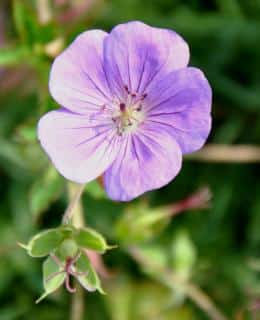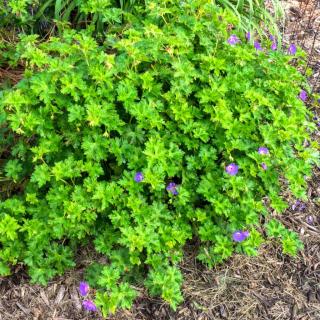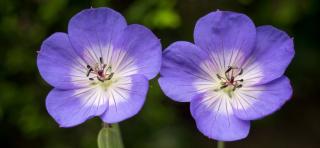

Geranium ‘Rozanne’ is a variety with one huge advantage: it’s a perennial. It resists freezing while maintaining incredible ornamental value.
Geranium Rozanne facts
Name – Geranium ‘Gerwat’
Trademark – Geranium Rozanne™
Family – Geraniaceae
Type – perennial
Height – 16 to 20 inches (40 to 50 cm)
Exposure – full sun, part sun
Soil: ordinary but well drained – Flowering: May to October
Ideal for ground cover and well suited to growing in pots or pot arrangements, geranium Rozanne also offers a very long-lasting blooming.
Preferably in fall or spring in a mix that includes geranium-specific soil mix.

Since Geranium Rozanne is a sterile hybrid, it will never produce seeds.

Cut back stems eventually after they have flowered in order to trigger production of new flowers and avoid draining your perennial geranium.
This pruning will also keep your Rozanne from getting leggy and spreading too far: cut branches back by half to trigger new branching out. You can do this in any season, but there are differences:
As resistant to diseases as it is hardy, no known disease seems to infect geranium Rozanne.
Leaves and smaller stems will die back with the cold.
For sustained blooming, water often but make sure excess water drains out.
This perennial is among the most abundant flower-bearing geraniums. More than anything, it is among those that bloom over the longest period. Indeed, the blooming extends from May up to the first fall frost spells. It can withstand summer heat.
Care, heat resistance and water needs are identical to those of Sunpatiens, another great sun-loving flower.
In a flower bed and also along edges and in rocky ground, geranium Rozanne can serve as excellent ground cover (like the Patricia geranium) and beautiful garden box items.
Geranium Rozanne was first bred and discovered in 1989, by Donald and Rozanne Waterer. They were growing several dozens of Geranium plants which Rozanne loved. One year, a particularly vigorous specimen appeared in their garden in Somerset in the United Kingdom. It flowered profusely the next year from spring to first frost. Rozanne had never seen such a bloom! Parent plants were Geranium himalayense and Geranium wallichianum.
The couple was already familiar with horticulture, since Donald had been born and raised in a family that loved gardening (they had bred many hardy azalea varieties in their heyday). He had managed it and this discovery came after he had retired. They got in touch with flower expert Graham Stuart Thomas.
Graham Thomas was already famed for his work on preserving old English roses heritage breeds. He guided the Waterers towards Adrian Bloom (of Blooms of Bressingham), a well-known horticulturist. After propagating, growing and testing the plant, they were able to patent it as a new development!

After 2 decades, this patent has expired in February 2019 (for the United States and GATT signatory countries). It’s now allowed to propagate your own, and even sell them!
It’s a beautiful example of how a passion for flowers can spread the world, since millions of specimens have been sold throughout the world.
You can provide it with geranium-specific organic liquid fertilizer once or twice in the season to increase blooming.
Also, Geranium Rozanne prefers slightly acidic soil rather than alkaline soil, so a good mulch to use is pine bark mulch or even coffee grounds.
My Roxanne has got very leggy it’s spreading over other plants how can I remedy this thank you
Hi Victoria, that’s a good question. I added to the article to explain how to solve the problem of leggy Rozanne geraniums.
Wanted to update this thread and ask for additional help. Over the space of three months, the Rozanne Geranium I bought lost all of her foliage. She went from a lush plant about 12″ in diameter with dozens of pretty purple flowers to one covered by black spots, to one with long, mostly bare horizontal shoots that died very suddenly. I kept cutting away the dead or dying leaves and stems. I hate giving up on my plants. I was reluctant to take your advice Gaspard, because I thought any further shock to the plant would kill it. I was also concerned that I had no warm place in the house to do the wash and transplant. It was below 30 degrees outside.
However, I eventually realized I had to do something. I found a spot in the garage (about 38 degrees there), and worked very quickly, figuring the thermal shock on the plant would be as bad as the mechanical shock. The root ball was like concrete. I dunked it repeatedly in tepid water to soften it up but finally had to resort to a knife to cut away some of the roots and hard dirt. I never did get the roots fully free of the soil. From what I could see, they weren’t particularly healthy looking. I finally got the plant back into a much smaller pot with potting soil and perlite.
I brought the plant back inside and then watched to my dismay as every last leaf died. I didn’t know if I dared water the plant, after all the dunking. So I delayed for a couple days. I feared the black spot would come back.. Finally I resorted to prayer. Yes, I pray for my plants’ health just as I pray for my friends and family. and a remarkable thing happened. About 4 days after I saw the last leaf shrivel and die, I saw a couple tiny green sprouts at ground level. I gave the plant a tiny bit of water. In three days it had 6 very slender stems, 6″ tall, each topped by healthy looking leaves! Amazing growth! However I have a new worry. They keep turning towards the window for light, and bending over. I’ve rotated the pot in an attempt to keep the stems straight, but they are now bent in multiple places. The stems haven’t “bulked up” as I hoped, or produced any other leaves. . They are so slender and delicate. I’m afraid they will break.. I decided to insert some bamboo shish-kabob skewers and use some soft yarn to support the stems. However, I wonder if this plant WANTS to fall over and creep like that weed, “Creeping Charlie”. If so, I may have her in too small a pot. What do you think I should do to fill out this plant?
I’m having trouble with a Rozanne Geranium. I hope you can help me. I bought it at a nursery in early September intending to take it to the cemetery. It was beautiful and blooming. A couple leaves had small black spots, which the nursery owner said were normal this time of year. It was root bound. I cut the root ball on the sides and bottom, and put it in a large pot with new potting soil snd perlite. I took it immediately to the cemetery (big mistake), where it immediately got hit with 24 hours rain followed by 24 hours of blistering sun. When I returned it was covered with black spots. I hate to let plants go. I brought the pot inside, hit it with Captan and Immunox. I kept trimming off the infected leaves. After a couple months the black spot disappeared. But the plant is not thriving. It has a small, tight cluster of leaves that never expands. It sends out long (10 – 1 2″ ) shoots that quickly turn brown and die. All the flowers have died. I’m wondering if I didn’t do a good enough job scoring the root ball, or if all the anti-fungal has stunted it’s growth.
Hi Jim, thanks for the thorough walk-through.
It sounds to me as though your geranium rozanne is set in “bonsai mode”. This happens when it has suffered a lot: the plant reverts to being much more cautious and only very grows very slowly. It’s seen also in trees and saplings that suffer from transplant shock; any good forester will tell you that however well you treat a stunted, one-foot tall sapling that’s already 6 or 7 years old, it will never grow into a tall, beautiful tree.
However, there is hope in your geranium, because it still tries to send out those shoots. I suspect that it is now in a situation where it doesn’t have enough nutrients to sustain growth, and furthermore, residual anti-fungal products in the soil may keep beneficial fungus from helping the plant out, too. Here’s what I recommend:
– transplant to a larger pot with fresh soil mix: Gently tease out soil from the root clump, you can even rinse the soil out with rainwater entirely (set the water near the pot for a day beforehand to avoid temperature shock). This will remove excess product which may be poisoning the plant. Afterwards, feed with diluted organic fertilizer, best is the home-made one.
– alternative path: start cuttings from your geranium. This will give each cutting a fresh start, and it will normally grow much healthier than the now stunted mother plant.
Of course, you can do both ideas at the same time! Hope this helps!
Thanks for your fast and very complete answer. Yes, I think you are probably right about the little girl. Too much suffering. Still, surprised that it still sends out long shoots, which promptly die.